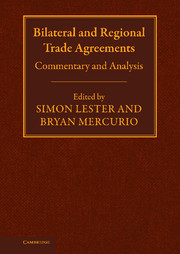Book contents
- Frontmatter
- Contents
- List of contributors
- Acknowledgements
- Foreword
- Table of cases
- Table of Treaties and International Agreements
- Table of abbreviations
- Part I Introduction
- Part II Economics and politics of PTAs
- 2 The economics of PTAs
- 3 The political economy of PTAs
- 4 Bilateral and plurilateral PTAs
- Part III Relationship with WTO and international law
- Part IV Legal aspects of PTAs: A comparative analysis
- Index
- References
2 - The economics of PTAs
Published online by Cambridge University Press: 16 December 2009
- Frontmatter
- Contents
- List of contributors
- Acknowledgements
- Foreword
- Table of cases
- Table of Treaties and International Agreements
- Table of abbreviations
- Part I Introduction
- Part II Economics and politics of PTAs
- 2 The economics of PTAs
- 3 The political economy of PTAs
- 4 Bilateral and plurilateral PTAs
- Part III Relationship with WTO and international law
- Part IV Legal aspects of PTAs: A comparative analysis
- Index
- References
Summary
Introduction
Strongly influenced by the perception that restricted commerce and preferences in trade relations had contributed to the economic depression of the 1930s and the subsequent outbreak of war, the discussions leading to the General Agreement on Tariffs and Trade (GATT) in 1947 were driven by the desire to create an international economic order based on a liberal and non-discriminatory multilateral trade system. Enshrined in Article I of the GATT, the principle of non-discrimination (commonly referred to as the most-favoured-nation or MFN clause) precludes member countries from discriminating against imports based upon the country of origin. However, in an important exception to this central prescript, the GATT, through its Article XXIV, permits its members to enter into preferential trade agreements (PTAs), provided these preferences are complete. In so doing, it sanctions the formation of Free Trade Areas (FTAs), whose members are obligated to eliminate internal import barriers, and Customs Unions (CUs), whose members additionally agree on a common external tariff against imports from non-members. Additional derogations to the principle of non-discrimination now include the enabling clause, which allows tariff preferences to be granted to developing countries (in accordance with the generalised system of preferences) and permits preferential trade among developing countries.
Such PTAs are now in vogue. Even as multilateral approaches to trade liberalisation – through negotiations organised by the GATT/WTO – have made substantial progress in reducing international barriers to trade, GATT/WTO-sanctioned PTAs have rapidly increased in number in recent years.
- Type
- Chapter
- Information
- Bilateral and Regional Trade AgreementsCommentary and Analysis, pp. 11 - 27Publisher: Cambridge University PressPrint publication year: 2009
References
- 3
- Cited by

